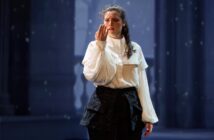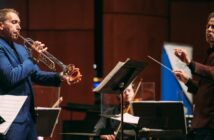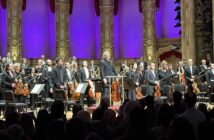Puccini’s final opera, Turandot, was famously left incomplete due to the composer’s untimely death. It premiered at Teatro alla Scala in 1926 using composer Franco Alfano’s ending based on fragments of vocal lines and indications for orchestration left by Puccini. Much controversy and critical dissatisfaction has always swirled around the Alfano ending prompting the commissioning of many alternate completions. The most famous of these is Italian composer Luciano Berio’s 2002 rendering which the Hungarian State Opera is currently using in their new production of Turandot, alternating in some performances with Alfano’s more familiar ending.

Polina Pasztircsák (Liù), Péter Fried (Timur) & Boldizsár László (Calaf) in Hungarian State Opera’s Turandot. Photo: Valter Berecz / Hungarian State Opera
Psychological Turandot
As director Dóra Barta indicates in her program notes, Berio’s final duet “takes us into the more cynical 21st century, demanding a psychologically consequent and more contemporary interpretation, in which the mere fact of love can repeatedly be challenged.” Barta’s vision underlines the brutality of Turandot’s realm with its corps of dancers, creepily hooded and masked, constantly spying on the populace. A gang of stormtroopers with face shields also keep everyone in check. Turandot herself has left a long line of suitors who are summarily executed when unable to answer her confounding riddles. In this context, Alfano’s more familiar anointment of Turandot and Calaf as the ‘happy couple’ with its encore of the opera’s big tune, “Nessun dorma,” would border on the absurd.
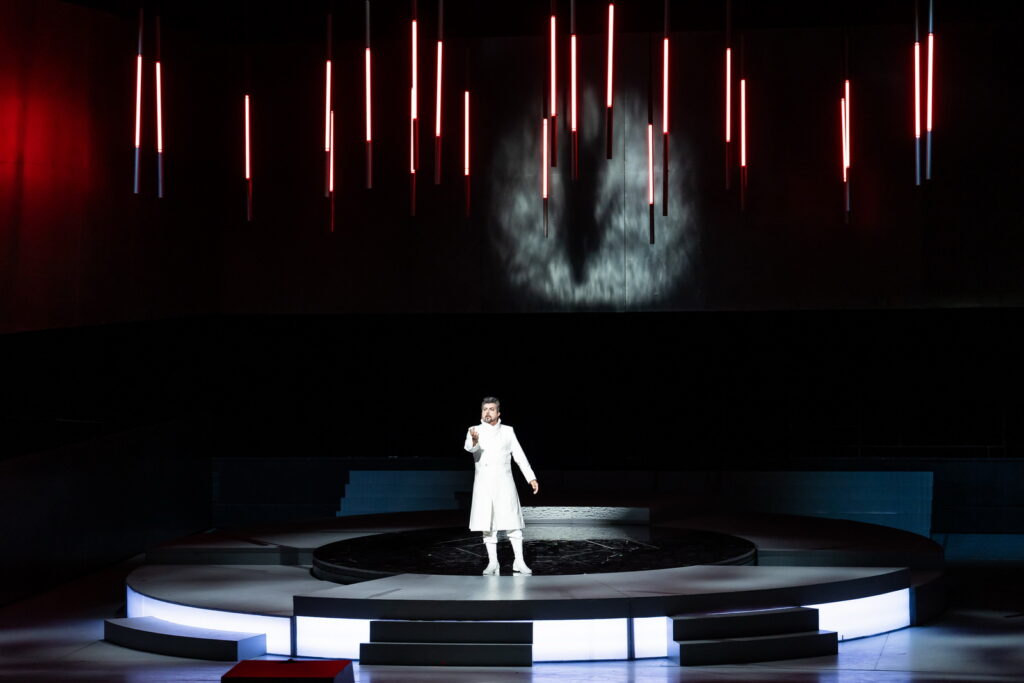
Boldizsár László (Calaf) in Hungarian State Opera’s Turandot. Photo: Valter Berecz / Hungarian State Opera
That tenor aria, sung by Calaf, happens to be the most famous opera melody in the current popular imagination. But the story it tells is brutal: “No one sleeps” in a land where Turandot has sanctioned the torture of anyone who might know her latest suitor’s name. Calaf has managed to answer the Princess’s three riddles to win her hand in marriage, but offers her one last chance for freedom if she can uncover his true identity. Her spies capture his blind father’s companion, Liù, who ultimately kills herself rather than reveal the name.
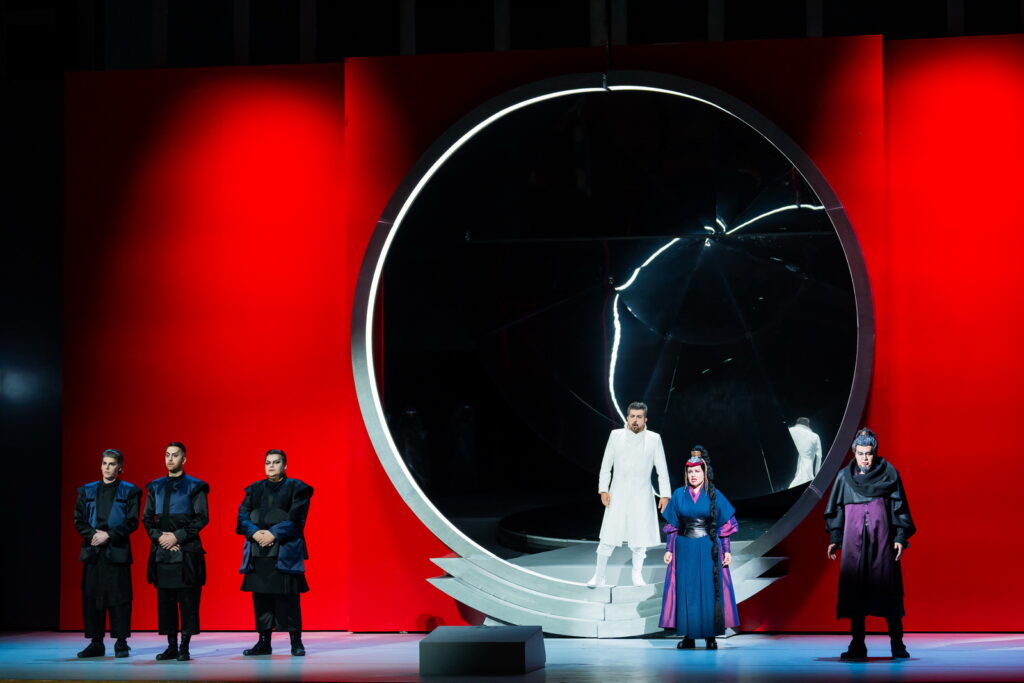
Scene from Hungarian State Opera’s Turandot. Photo: Valter Berecz / Hungarian State Opera
This brutal reality is reflected in the hard, geometric edges of Ildi Tihanyi’s sets and costumes. A huge silver gong looms over a round central platform that raises and lowers to reveal a frosted glass chamber beneath. It serves as the altar on which Turandot’s suitors are executed, and where Liù also meets her demise. The lower chamber is used intriguingly at the end of Act 1 as a holding pen for the Princess where she paces, anticipating her fate now that Calaf has answered the riddles. Tihanyi’s costumes are clean-lined, contemporary evocations of traditional Chinese Mandarin collar suits.
Any production of Turandot puts considerable demands on an opera company given its huge chorus and orchestra, and demanding principal roles. The Hungarian State Opera Chorus met the challenge, offering impressive volume, but also more subtle shadings as required. There were a few coordination problems with the pit at the start, possibly due to sight lines being obscured by the abundance of downstage choreographed movement. A special mention must go to the company’s children’s chorus whose tones rang out clearly. The Hungarian State Opera Orchestra, led by the company’s principal guest director, Péter Halász, brought out all the intricacies of Puccini’s most harmonically advanced score.
Berio’s Turandot ending
The Berio ending itself is intriguing. For the most part, its vocal lines are familiar from the Alfano completion, but their more dissonant orchestration here reflects Turandot’s mentally fractured state, while still managing some connection to Puccini’s sound world. Barta subtly depicts all of this with Turandot standing alone downstage at the opera’s conclusion, separated from Calaf who crowns himself as Emperor upstage. The Princess has in fact potentially lost her exalted position to a man about whom she is clearly ambiguous.
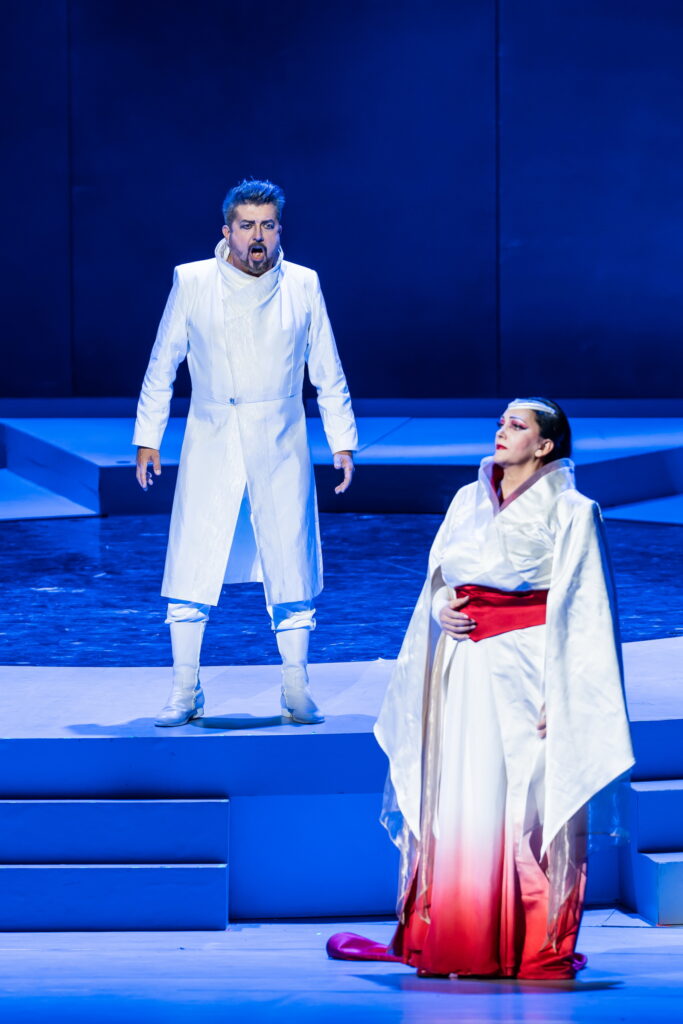
Boldizsár László (Calaf) & Eszter Sümegi in the title role of Hungarian State Opera’s Turandot. Photo: Valter Berecz / Hungarian State Opera
As Turandot, soprano Eszter Sümegi’s bright, penetrating sound soared over Puccini’s heavy orchestration. Tenor Boldizsár László likewise offered a big sound and strong stage presence in one of canon’s most challenging heroic roles. The most affecting and beautiful singing of the night came from soprano Polina Pasztircsák as Liù. Here, gorgeous tone was married to strong textual delivery and intention of phrase to create a memorable, moving portrayal.
Bass Péter Fried made the most of his touching farewell to Liù, though it was difficult to tell if he had been directed to be blind as in most traditional stagings. Among the three ministers of state, Ping, Pang and Pong, tenor Tibor Szappanos stood out for his clear, carrying tone and characterful delivery of text.
As is traditional with the role of Turandot’s father, the Emperor Altoum was cast with a distinguished veteran tenor, in this case, Dénes Gulyás, who enjoyed an important international career in the 1970s and 1980s. Here, this experience shone through with his keen demonstration of Puccinian style, and a still-attractive and sizeable tone.
There were times when choreography and stage business unnecessarily distracted from the main action. This was particularly an issue in Ping, Pang and Pong’s scene as they dreamily reminisce about their bamboo home in the country. Barta’s masked spies enter with a large, lit-up parasol which they spin endlessly to no great effect. This was one of several instances where superfluous movement was introduced while the chorus, for example, remained mostly static throughout.

Scene from Hungarian State Opera’s Turandot. Photo: Valter Berecz / Hungarian State Opera
Nevertheless, this new Turandot is a considerable achievement for the company, offering an intriguing opportunity to experience a conclusion that feels more in line with contemporary discourse on relationships, and who knows, maybe even with Puccini’s own interrupted intentions.
Hungarian State Opera’s new production of Turandot continues its run through November 29.




